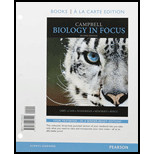
Concept explainers
Which factor most likely caused animals and plants in India to differ greatly from species in nearby southeast Asia?
- A. The species became separated by convergent evolution.
- B. The climates of the two regions are similar.
- C. India is in the process of separating from the rest of Asia.
- D. India was a separate continent until 45 million years ago.
Introduction:
The Earth is not made up of one compact rock, instead, it is made up of seven different rocks or plates called the tectonic plates. These plates are in a state of continuous movement, but they move at a very slow pace. This property of movement of the continents across the Earth’s surface through the geological time is called continental drift.
Answer to Problem 1TYU
Correct answer:
There was a crash between two of the seven tectonic plates. The Eurasian plate and the Indian plate crashed with each other. It is because of this crash, the formation of the Himalayan mountain system took place. Hence, India was a separate continent until forty-five million years ago. Therefore, the animals and plants of India differ from the species in Southeast Asia. Thus, option (D) is correct.
Explanation of Solution
Reason for the correct statement:
Continental drift is one of the major factors responsible for changes in the formation of mountain eruption of the volcanoes. Mountains affect the climate of a country significantly by blocking wind and air masses. They also cause rainfall in a country. Species from India differ from Southeast Asia because “India was a separate continent until 45 million years ago”.
Option (D) is given as “India was a separate continent until 45 million years ago”.
“The factor that most likely caused animals and plants in India to differ greatly from species in nearby Southeast Asia is that India was a separate continent until 45 million years ago”, hence, it is the right answer.
Hence, option (D) is correct.
Reason for the incorrect statements:
Option (A) is given as “The species became separated by convergent evolution”.
Variations in the animals and plants of India from species in Southeast Asia are because of the Himalayan mountains, and not because the species became separated by a convergent evolution. Hence, it is the wrong answer.
Option (B) is given as “The climates of the two regions are similar”.
There are differences between animals and plants of India from species in Southeast Asia because of the Himalayan mountains and not because of the similarity in the climate. Hence, it is the wrong answer.
Option (C) is given as “India is in the process of separating from the rest of Asia”.
The plants and animals of India differ from their counterparts from Southeast Asia because of the Himalayan mountains and not because India is in the process of separating from the rest of Asia. Hence, it is the wrong answer.
Hence, options (A), (B), and (C) are incorrect.
Continental drift along with the Himalayan mountains are responsible for the difference between the Indian plants and animals from Southeast Asia.
Want to see more full solutions like this?
Chapter 23 Solutions
Campbell Biology in Focus, Books a la Carte Edition; Modified Mastering Biology with Pearson eText - ValuePack Access Card - for Campbell Biology in Focus (2nd Edition)
Additional Science Textbook Solutions
Chemistry: Structure and Properties (2nd Edition)
Laboratory Manual For Human Anatomy & Physiology
Microbiology Fundamentals: A Clinical Approach
Human Physiology: An Integrated Approach (8th Edition)
The Cosmic Perspective (8th Edition)
- 1. Match each vocabulary term to its best descriptor A. affinity B. efficacy C. inert D. mimic E. how drugs move through body F. how drugs bind Kd Bmax Agonist Antagonist Pharmacokinetics Pharmacodynamicsarrow_forward50 mg dose of a drug is given orally to a patient. The bioavailability of the drug is 0.2. What is the volume of distribution of the drug if the plasma concentration is 1 mg/L? Be sure to provide units.arrow_forwardDetermine Kd and Bmax from the following Scatchard plot. Make sure to include units.arrow_forward
- Choose a catecholamine neurotransmitter and describe/draw the components of the synapse important for its signaling including synthesis, packaging into vesicles, receptors, transporters/degradative enzymes. Describe 2 drugs that can act on this system.arrow_forwardThe following figure is from Caterina et al. The capsaicin receptor: a heat activated ion channel in the pain pathway. Nature, 1997. Black boxes indicate capsaicin, white circles indicate resinferatoxin. a) Which has a higher potency? b) Which is has a higher efficacy? c) What is the approximate Kd of capsaicin in uM? (you can round to the nearest power of 10)arrow_forwardWhat is the rate-limiting-step for serotonin synthesis?arrow_forward
 Concepts of BiologyBiologyISBN:9781938168116Author:Samantha Fowler, Rebecca Roush, James WisePublisher:OpenStax College
Concepts of BiologyBiologyISBN:9781938168116Author:Samantha Fowler, Rebecca Roush, James WisePublisher:OpenStax College
 Biology Today and Tomorrow without Physiology (Mi...BiologyISBN:9781305117396Author:Cecie Starr, Christine Evers, Lisa StarrPublisher:Cengage Learning
Biology Today and Tomorrow without Physiology (Mi...BiologyISBN:9781305117396Author:Cecie Starr, Christine Evers, Lisa StarrPublisher:Cengage Learning- Essentials Health Info Management Principles/Prac...Health & NutritionISBN:9780357191651Author:BowiePublisher:Cengage
 Human Biology (MindTap Course List)BiologyISBN:9781305112100Author:Cecie Starr, Beverly McMillanPublisher:Cengage Learning
Human Biology (MindTap Course List)BiologyISBN:9781305112100Author:Cecie Starr, Beverly McMillanPublisher:Cengage Learning Biology (MindTap Course List)BiologyISBN:9781337392938Author:Eldra Solomon, Charles Martin, Diana W. Martin, Linda R. BergPublisher:Cengage Learning
Biology (MindTap Course List)BiologyISBN:9781337392938Author:Eldra Solomon, Charles Martin, Diana W. Martin, Linda R. BergPublisher:Cengage Learning





